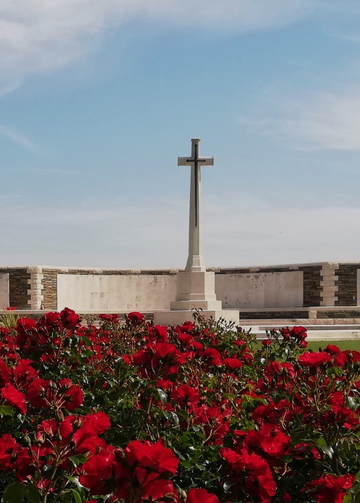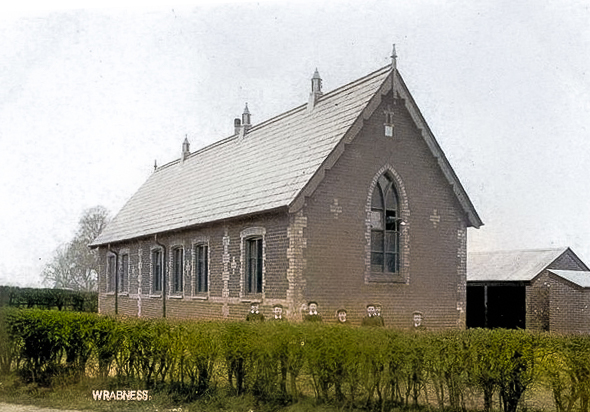Christian Clyde FISHER
Eyes hair dark brown, Hair eyes brown, Complexion fair
Christian Clyde Fisher - Short and Stout
Can you help us identify Christian?
Christian Fisher was killed in Action at Fromelles. As part of the 32nd Battalion he was positioned near where the Germans collected soldiers who were later buried at Pheasant Wood. There is a chance he might be identified, but we need help. We are still searching for suitable family DNA donors.
In 2008 a mass grave was found at Fromelles, a grave the Germans dug for 250 (Australian) bodies they recovered after the battle.
If you know anything of contacts here in Australia or his relatives from Essex, England, please contact the Fromelles Association.
See the DNA box at the end of the story for what we do know about his family.
With thanks to Geoff Tilley, In Search of Charles Albert Stokes DCM, for his contribution to the preparation of this story.
Christian’s Early Years
Christian Clyde Fisher was born in Wrabness, Essex, England in April 1887 to parents Edward Francis and Elizabeth (nee Porter) Fisher. He was the ninth of their twelve children:
- Rosanna Elizabeth Mary 1871–1960
- Caroline Lily Elizabeth 1872–1948
- Adelaide Eva Louisa 1875–1954
- Georgiana Ada 1877–1877
- Minnie Selina 1879–1938
- Edward Oswald 1881–1964
- Bernard Cardinall 1883–1952
- Lewis Duncan 1885–1940
- Christian Clyde Fisher 1887–1916
- Cecil Stanley 1889–1961
- Lydia Cardinall 890–1954
- Francis Wilfred 1897–1971
He was baptised at the Wrabness, All Saints Church in June 1887, where his parents had been married in May 1868. Unfortunately, Christian’s mother died in 1894 when Christian was just seven. His father remarried in December 1896 to Susannah Parish.
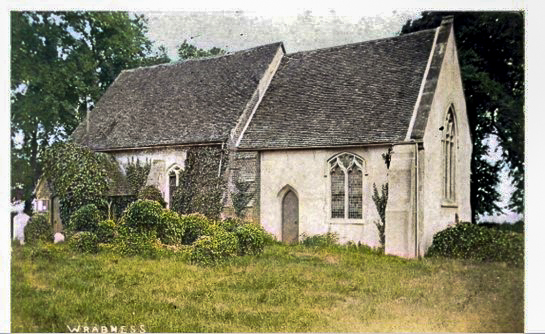
As he was growing up, Christian attended the National School in Wrabness.
Given the rural nature of the area, he likely worked in farming, as noted by his father in his Honour Roll Circular and by about 1908 he was serving with the 5th Essex Battalion Territorial Infantry Force. He also was the best man at his oldest brother Edward’s wedding.
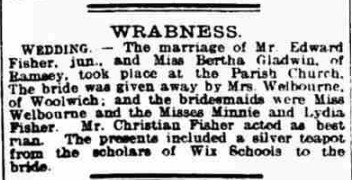
At 24 years old, he resigned from the Territorial Infantry Force and migrated to Perth, Western Australia in 1911. His movements after his arrival in Western Australian are not well known, but it is recorded that he moved to Wickepin near Narrogin, 200 km SE from Perth, and was working as a labourer with the West Australian Government Railways. Narrogin was a major hub for the railroad.
Off to War
While now on ‘the other side of the world’, he still felt the call to serve and enlisted in the Australian Infantry Force in July 1915. While only 5’3” tall, he did fit within the new minimum height criteria which had been adopted in June 1915. He was assigned to the newly formed 32nd Battalion, D Company and was sent to the Blackboy Hill Camp for his military training.
The 32nd had been raised on the outskirts of Adelaide, South Australia as part of the 8th Brigade, with A and B Companies to be from South Australia and C and D Companies from Western Australia. Back home, his older brother Lewis enlisted with the Royal Artillery Garrison.
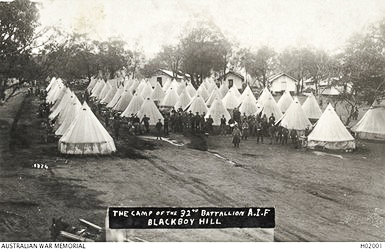
At the end of September 1915, the WA 32nd soldiers sailed from Fremantle to Adelaide to join the other half of the battalion and to continue their military training.
They embarked from Adelaide, South Australia on 18 November 1915 aboard HMAT Geelong A2 , headed for Egypt. They arrived in Suez on 14 December 1915 and moved to the El Ferdan camp just before Christmas. A month later they marched to Ismalia, then to the large camp at Tel El Kabir for February and most of March.
The next stops were at Duntrooon Plateau and Ferry Post until the end of May, training and guarding the Suez Canal. Their last posting in Egypt was a few weeks at Moascar. One soldier’s diary complained of being “sick up to the neck of heat and flies”, of the scarcity of water during their long marches through the sand and he described some of the food as “dog biscuits and bully beef”.
He did go on to mention good times as well, with swims, mail from home, visiting the local sights and the like.
Source AWM C2081789 Diary of Theodor Milton PFLAUM 1915-16, You can read Theodor’s Soldier Story here
During their time in Egypt the 32nd had the honour of being inspected by H.R.H. Prince of Wales. After spending six months in Egypt, the call to support the British Expeditionary Force on the Western Front came in mid-June. They left from Alexandria on the ship Transylvania on 17 June 1916 arriving at Marseilles, France on 23 June 1916.
They then were put on trains for the two-day trip to Steenbecque, near the Belgian border. Their route took them to a station just out of Paris, within sight of the Eiffel Tower, then through Bologne and Calais, with a view of the Channel before marching to their camp at Morbecque, about 30 kilometres from Fleurbaix.
Theodor Pflaum (No. 327) wrote about the trip in his diary:
“The people flocked out all along the line and cheered us as though we had the Kaiser as prisoner on board!!”
Fromelles
The 32nd moved to the front on 14 July and were into the trenches for the first time on 16 July, in preparation for an assault on the German trenches at Fromelles. Christian’s D Company’s Lieutenant Sam Mills’ letters home were optimistic for the coming battle:
“We are not doing much work now, just enough to keep us fit—mostly route marching and helmet drill. We have our gas helmets and steel helmets, so we are prepared for anything. They are both very good, so a man is pretty safe.”
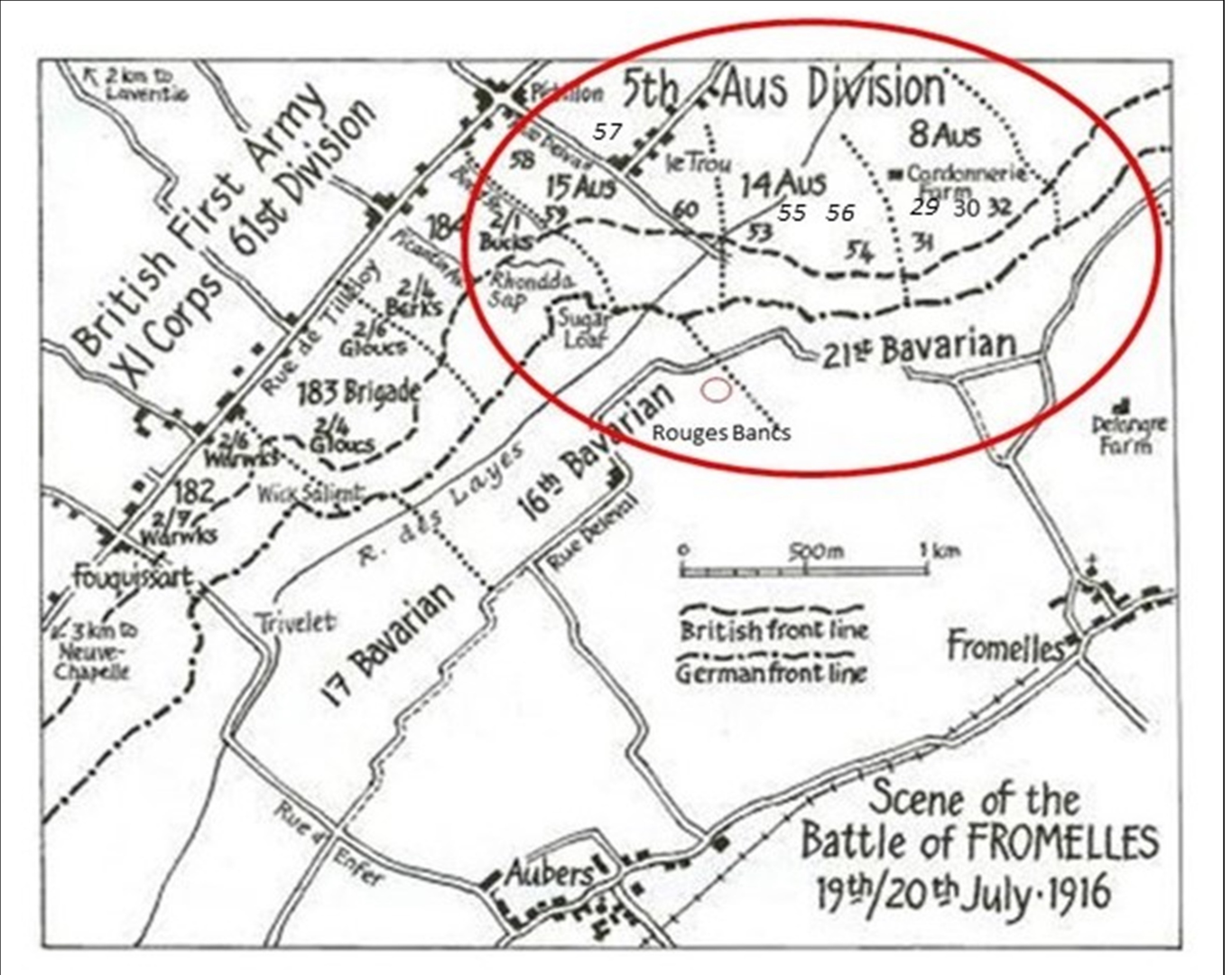
On the 17th they were reconnoitring the trenches and cutting passages through the wires, preparing for an attack, but it was delayed due to the weather. The Australian 8th Brigade, which included the 32nd Battalion, were to cross about 100 metres of No-Man’s-Land and assault the German trenches on the left flank of the Allied attack.
Being on the extreme left flank made their job made even more difficult, as, not only did they have to protect themselves from the front, but they also had to block off the Germans on their left while advancing in order to prevent the Germans from coming around behind them. All were in position by 5.45 PM and the charge over the parapet began at 5:53 PM.
A and C Companies were the first and second waves to go, with Christian’s D and B Company in the third and fourth wave. The first waves did not immediately charge the German lines, they went out into No-Man’s-Land and laid down, waiting for the British bombardment to lift. At 6:00 PM, the German lines were rushed.
The Australians immediately suffered heavy casualties from the artillery and German rifle and machine gun fire but were successful in their initial assaults and by 6.30 PM were in control of the German’s 1st line system.
Unfortunately, with the success of their attack, ‘friendly’ artillery fire caused a large number of casualties. They were able to take out a German machine gun in their early advances, but they were being “seriously enfiladed” from their left flank. By 8:30 PM their left flank had come under heavy bombardment with high explosives and shrapnel.
Return bombardment support was provided and the 32nd was told that “the trenches were to be held at all costs”.
Source AWM4 23/49/12, 32nd Battalion War Diaries, July 1916, page 12
It was about at this time when Christian was killed by shrapnel from an artillery shell, as reported by Private S.M. Redmond (1351).
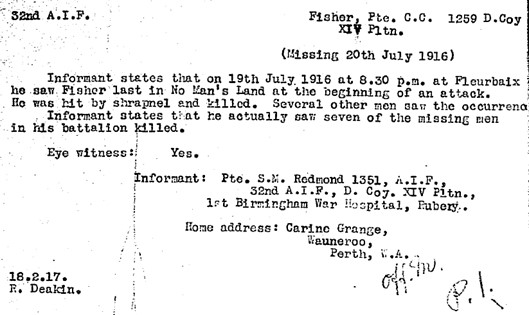
Private A. Mather (1316) also said that they had fallen into a German trap and that Christian had been severely wounded and had to be left.
Source: Australian Red Cross Wounded and Missing Files – Christian Clyde FISHER, p 2
Fighting continued through the night. The Australians made a charge at the main German line, but they were low on grenades, there was machine gun fire from behind and from the machine gun emplacement at Delangre Farm and they were so far advanced that they were getting shelled by both sides.
At 4.00 AM the Germans began an attack from the Australian’s left flank. Given the Australian advances that had been made earlier, their rear trench had been left almost empty, which then enabled the Germans to be in a position to surround the soldiers of the 32nd.
At 5.30 AM the Germans attacked from both flanks in force and with bombing parties:
“The enemy swarmed in and the retirement across No Mans’ Land resembled shambles, the enemy artillery and machine guns doing deadly damage.”
What was left of the 32nd had finally withdrawn by 7.30 AM on the 20th. The initial head count was devastating – 71 killed, 375 wounded and 219 missing, including Christian.
To get some perspective of the battle, when Charles Bean, Australia’s official war historian, attended the battlefield two and half years later, he observed a large amount of bones, torn uniforms and Australian kit still on the battlefield.
The final impact was that 225 soldiers of the 32nd Battalion were killed or died from wounds sustained at the battle and of this 166 were unidentified.
Where is Christian?
Christian was initially reported as missing. In late September, his sister Lydia wrote to find out more.
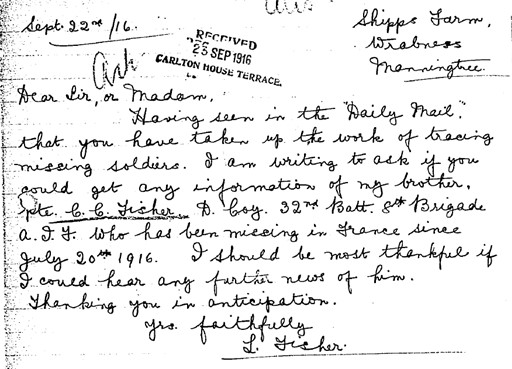
In early February 1917 Lydia was advised that a Private Jenkinson (3168) stated that he saw Christian in England at a Convalescent Camp Perham Downs Salisbury Plains, BUT he described him as “tall and thin, fair and cleanshaven and about 24 years old”.
The Red Cross did note that this news appeared to be unreliable as Christian would have been in contact with the family if he was back in England.
Source Australian Red Cross Wounded and Missing Files – Christian Clyde FISHER, p 16
Lydia quickly replied:
“I am sorry to say (this) would not be my brother, as the information given is quite the reverse. My brother was short and stout also had dark hair, his age being 28.”
(note: Christian was 5’3” and 179 pounds)
Private Redmond’s sadder, but more accurate, report about Christian’s death was passed to Lydia in March. A court of inquiry was held “in the field” on 12th August 1917 that Private Christian Clyde Fisher of 32nd Battalion, D Company was pronounced as killed in action on 20 July 1916.
He was 29 years of age. He has no known grave. More than 100 years later he remains as missing. Christian was awarded the 1914-15 Star, British War and Victory medals, as well as a Memorial Scroll and a Memorial Plaque.
Christian is commemorated at:
- VC Corner Australian Military Cemetery, Fromelles France VC Corner Panel 5, Fromelles, France
- Australian War Memorial, Panel 120, Canberra
- All Saints Church, Wrabness, Essex
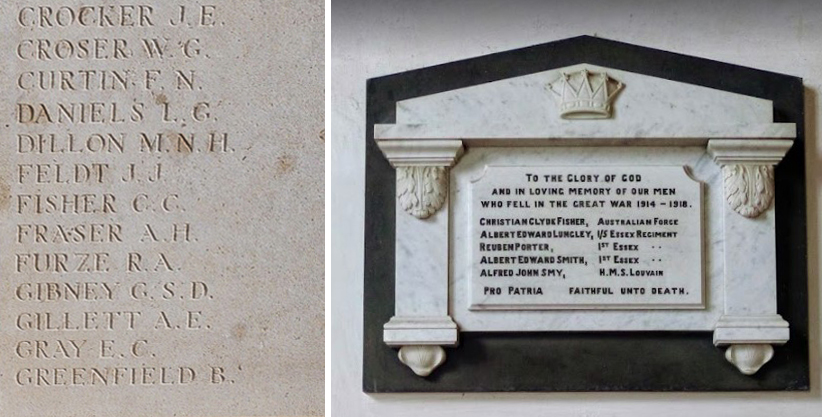
Can you help to identify Christian?
As of 2024, 41 of the 166 originally unidentified soldiers from the 32nd have been confirmed to be in the German mass grave at Pheasant Wood that was found in 2008. These soldiers have now been given a proper burial and recognition.
There are a further 70 soldiers from the grave who are as yet unidentified. One of them could be Christian. We are currently seeking MT-DNA particularly from the sisters of Elizabeth Porter or her mother Rachel Osborn(e).
DNA samples are being sought from the maternal line. (The Porter and Osborne lines). Specifically, Christian C Fishers Mother, sisters, grandmother, aunts etc.
| Soldier | Christian Clyde Fisher (1887-1916) |
| Parents | Edward Francis Fisher (1843-1921) and Elizabeth Porter (1849-1894), Wrabness, Essex | ||
| --- | --- | --- | --- |
| Siblings | Rosanna Elizabeth Mary (1871–1960) | ||
| Caroline Lily Elizabeth (1872–1948) | |||
| Adelaide Eva Louisa (1875–1954) | |||
| Georgiana Ada (1877–1877) | |||
| Minnie Selina (1879–1938) | |||
| Edward Oswald (1881–1964) | |||
| Bernard Cardinall (1883–1952) | |||
| Lewis Duncan Fisher (1885–1940) | |||
| Cecil Stanley (1889–1961) | |||
| Lydia Cardinall (1890–1954) | |||
| Francis Wilfred (1897–1971) |
| Grandparents | |||
| Paternal | Edward Fisher (1814-1873) and Mary Lilley (1815-1888) | ||
| Maternal | John Porter (1820-1894) and Rachel Osborn(e) (1814-1895) |
Seeking DNA Donors

Contacts
(Contact: royce@fromelles.info or geoffrey@fromelles.info).
(Contact: army.uwc@defence.gov.au or phone 1800 019 090).
Donations
If you are able, please contribute to the upkeep of this resource.
(Contact: bill@fromelles.info ).
